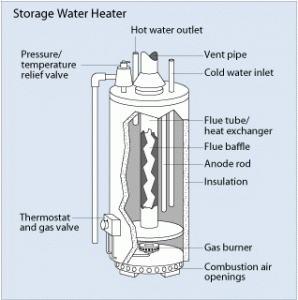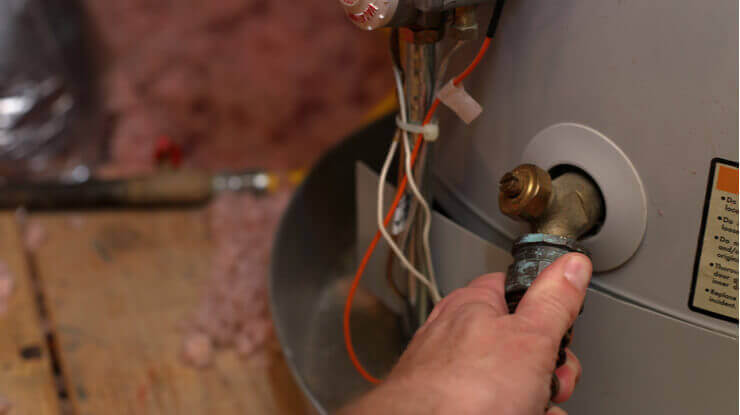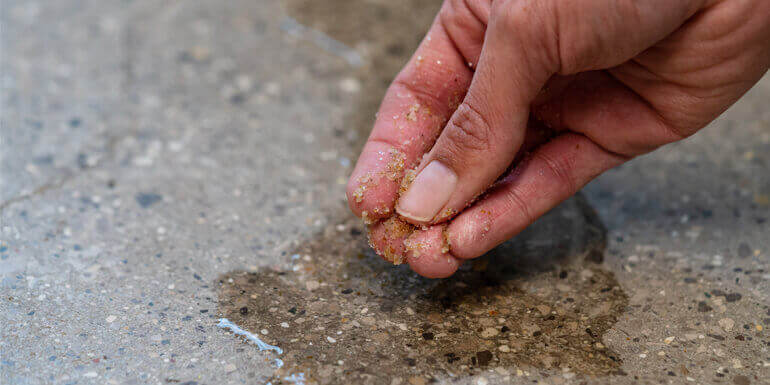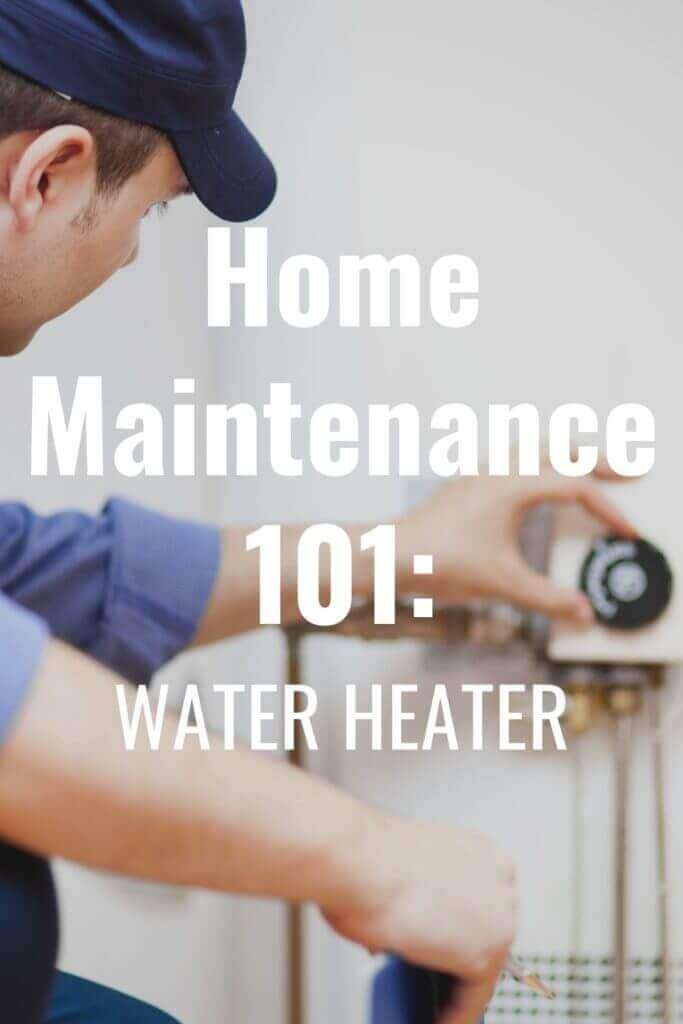Water heater maintenance is an important step to keep your natural gas bill under control. Although heaters that run on natural gas use less energy and are more cost-effective than electric water heaters, they aren’t necessarily problem-free. High gas bills could still be a concern if you don’t maintain your water heater properly.
Water heaters account for approximately 17% of your total household energy expenditure, according to Energy.gov. That’s why it’s important to understand how gas water heaters work and how to maintain them.
How Does a Gas Water Heater Work?
A gas powered water heater makes use of a gas burner. When the cold water is brought into the tank via a dip tube, this burner heats the water.
As the natural gas burns, it releases gases that move up through the tank via a central chimney. As the air moves up to get out, both the metal of the chimney and the surrounding water are heated.
Warm water then rises, moving through the heat-out pipe throughout the plumbing of the entire house. So, when you open a faucet to get hot water, the dip tube brings in cool water to displace the hot water that’s pushed out.
The thermostat on the water heater controls the amount of gas used to heat the water. Remember, a gas water heater (or electric water heater) works to maintain the temperature at a constant level in the tank.
The higher the temperature setting, the more gas is used to reach and maintain this temperature.

How do I Perform Water Heater Maintenance?
Most gas water heaters will last 12 to 15 years before they need replacement. Here are some simple water heater maintenance items that can help prolong the life of your gas water heater. (These same tips apply to electric water heaters.)
Check the thermostat
Energy.gov recommends a water temperature of 120 degrees Farenheit for your water heater. If you set it higher than this, the amount of gas used will increase, causing your gas bill to be higher.
Check the temperature of the water exiting your faucets. It should be approximately 120 degrees (or match the setting on your water heater thermostat). If it’s not, there could be a few factors in play.
First, your thermostat on the water heater may not be operating correctly. Second, you could be losing heat through uninsulated pipes as hot water travels from your water heater tank to your faucet. And third, your water heater may have built-up sediment that’s causing it not to work as efficiently. (More on that below.)
Test the pressure relief valve annually
Next, test the temperature and pressure relief valve (T&P valve) annually. This valve helps to monitor and control the pressure inside your water heater’s tank. If there’s a pressure issue, water will leak from this valve to avoid a pressure build-up. (That’s a good thing!)
The T&P valve is usually on the top or side of the heater, with a drainage pipe connected to it. You’ll need to disconnect the pipe using a wrench and put a bucket or bowl underneath to catch water.
Once that’s done, lift the lever on the valve, but not all the way up. This will result in a slow flow of water from the valve. And, air and steam will be released.
If that doesn’t happen, that means the pressure relief valve needs replacing ASAP. Contact a plumber for this task.

Flush out sediment from the tank annually
Sediment is the main culprit for water heaters that malfunction or even stop working. It builds from minerals that are naturally present in water, with substances collecting in the bottom of the tank.
It may take the shape of sand or small particles, creating an unnecessary barrier. This makes it harder for the heater to heat the various appliances throughout the home, hence racking up the bill.
A year is enough time for sediment to clog the bottom of the tank. That’s why flushing annually may improve a gas water heater’s lifespan. And it’s a very important part of water heater maintenance.
Annual sediment flushing should be enough to ensure a gas water heater is able to do its job efficiently. Unfortunately, if left unfixed for too long, the heater could break down.
The worst case scenario is, the metal tank has become brittle, leading to cracks and tiny holes that cause leaks. This can no longer be fixed and will require total replacement of the heater.
Check the anode rod every 3 years
The next item in water heater maintenance is checking the anode rod.
For those not familiar, this rod is the little superhero that saves the water heater from rusting away. Since water rusts metal, logic dictates that the tank should be rusting. But it doesn’t, because of the small anode rod inserted in the top of the tank.
Made of magnesium or aluminum, which corrodes quickly in water, the “sacrificial rod” rusts away so the tank remains intact. However, once it has completely rusted, the tank is next, and that’s why the rod must be replaced immediately. Otherwise, you’ll notice rusty water and/or heater malfunction.
It’s standard to check for the anode rod every 3 years. Do this by loosening the hex head screw to remove the anode rod. You should replace the rod if it’s less than 1/2 inch thick, if it’s coated with calcium or if more than 6 inches of the core steel wire is exposed.
You can replace this rod yourself, or contact a plumber to assist.
[optin-monster slug=”j6yxek2jjf6tgem8fsqq”]How Can I Tell if My Water Heater Has Sediment?
Most of the U.S. has hard water. In fact, hard water is found in 85% of the U.S. water supply. Calcium and magnesium in the water can cause calcium carbonite or lime scale to build up in your water heater. At extreme levels, the sediment can become almost like gravel in your water heater.
So if you’ve never flushed your water heater, you likely have sediment in it.
You can tell if you have mineral deposits or sediment in your water heater just by listening.
One indicator? You’ll hear knocking or banging sounds coming from it, meaning sediment has hardened at the bottom of the tank. The sounds will indicate your water heater is working harder to do it’s job. And that means you’re using more natural gas to heat your water.
A second indicator can be found by knocking on the outside of the water heater. The sound should be the same up and down the water heater tank. If the sound is different at the bottom vs. the top? Then that’s likely due to sediment in the tank.
Other signs of sediment in your water heater include:
- There is no hot water
- The water temperature fluctuates
- Your hot water looks rusty
- Water takes a long time to heat up

How do I Flush a Water Heater to Remove Sediment?
Flushing your water heater to remove sediment is a simple process, but it’s the part of water heater maintenance that too many home-owners ignore. We recommend making it part of your Fall home maintenance list.
Time needed: 3 hours
How to flush sediment from a hot water heater
- Turn off the water heater
Turn the thermostat knob to off. Your water heater may also have a setting that says “pilot.”
- Turn off the gas to the water heater
As an additional safety measure, turn the gas off completely. You’ll find the valve on the gas line entering the water heater
- Turn off the cold water supply faucet
The cold water valve is typically on the top of your water heater and looks like a normal outdoor faucet.
- Open the pressure relief valve (optional)
Opening the pressure relieve valve can help water flow more easily when draining. Be careful, as this water will be very hot.
- Let the water in your tank cool before proceeding.
Depending on the size of your water tank, this can take 2-3 hours.
- Enter your home and turn on the hot water to drain the pipes.
Turn the hot water on in two points, such as a sink and a tub. That will prevent a vacuum from forming in the water lines while you are draining the water tank.
- Connect a garden hose to the drain valve on the water tank
You’ll find the drain valve on the side of the tank. Connect the hose to the tank. Then make sure the other end of the hose leads outside. If your water tank is in the basement, you may need a large bucket and a portable pump to pump water outside.
- Turn on the drain valve spigot and drain the water tank
Drain your water tank until the water runs clear. If you have drained the sediment from your tank regularly, you may need to only drain 1/4 to 1/2 of your tank.
- Flush the tank with cold water
If you have a large amount of sediment, you may need to drain the tank completely and flush the tank with cold water to remove all the sediment. To flush the tank, turn on the cold water spigot to allow cold water to enter the tank. Let it run a few minutes, until only clear water is exiting the drain hose.
- Once the sediment has drained, return everything to it’s normal settings.
Turn off the drain valve and remove the hose. Close the pressure relief valve if you opened it. Turn off the water faucets that you had running in the house. Then turn on the cold water spigot to allow the tank to refill with water.
- Turn the water heater thermostat to the 120* setting and relight the pilot light.
- Test for hot water after 30 minutes
If flushing your water heater seems out of your skill set (or is just something you prefer not to do), you can contact a local plumber to perform this task for you.
Maintaining your gas water heater can help to keep your water heater functioning properly. And maintenance can help you avoid a high gas bill.
Water heater maintenance should be a must-know for anyone who owns a natural gas water heater. After all, if maintained properly, the energy this appliance conserves in your home is well worth it.
Looking for more ways to lower your natural gas bill? Here are tips to lower your winter gas bill. Or, if you’re in a deregulated gas market, you can cut your gas supply rate by shopping for natural gas in Georgia, Ohio or Michigan.
Gas Water Heater FAQs
Here are a few more frequently asked questions about gas water heaters.
If your water heater is making a knocking sound, that’s an indicator that you have sediment in your water tank. Sediment occurs naturally due to chemicals and minerals in the water (i.e. “hard water). When heated, these chemicals and minerals break down and produce sediment. If your water heater is making a knocking sound, you should flush your water heater, or contact a plumber.
According to Energy.gov, the most energy efficient setting for a water heater is 120* Farenheit. If you have children or elderly in the home, you may want to set it at a lower temperature for safety. If you find that you need a higher setting to get hot water, you may want to check your water heater for sediment. Sediment in your water heater can make it work overtime, causing it to heat inefficiently.
More often than not, a heater isn’t producing hot water because the gas burner has gone out. Check to see if the pilot light is burning on your water heater.
If it isn’t lit, you have a few choices. You can contact a plumber to relight it for you. Or follow these instructions to light the water heater pilot light.
A pilot light self-extinguishing is not normal. If it happens multiple times, there could be a serious issue with your water heater and you should contact a plumbing professional.
If you do shut off your water heater when you go on vacation, be prepared to relight the pilot light when you return. A better option is to turn the water heater down to a lower setting. Some water heaters even have a setting called “vacation.” That will keep your gas water heater from firing and maintaining a high temperature while you’re away.
Pin this article on water heater maintenance to save for later!

